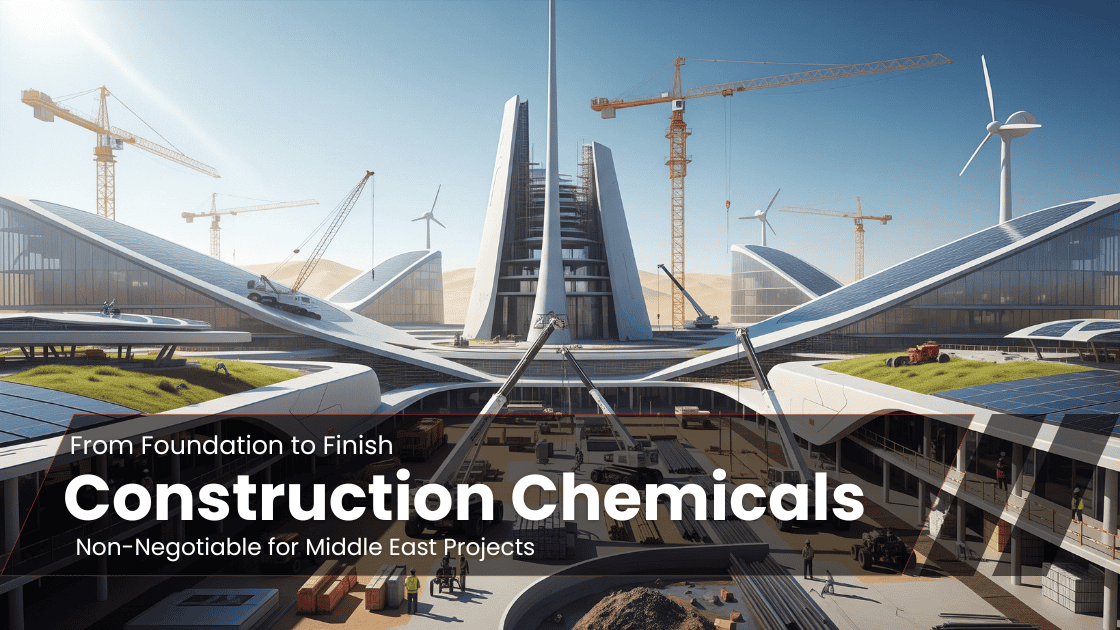The skylines of the Middle East are constantly evolving, testament to an unprecedented construction boom fueled by ambitious mega-projects and diversification away from oil economies. But beyond the glittering facades and towering cranes, an unsung hero is at work, ensuring the longevity, efficiency, and sustainability of these monumental endeavors: construction chemicals.
From the foundational concrete to the final protective coatings, these specialized formulations are the unseen backbone of modern construction. And in the unique climate and ambitious vision of the Middle East, their scope is not just significant – it’s transformative.
The Driving Forces Behind the Demand:
The Middle East’s appetite for construction chemicals is driven by several powerful factors:
- Mega-Projects & Infrastructure Development: Nations like the UAE and Saudi Arabia are investing trillions in futuristic cities (NEOM, The Line), vast transportation networks (Etihad Rail), and world-class tourism destinations. These projects demand high-performance materials that can withstand extreme conditions and deliver extended service lives with minimal maintenance.
- Rapid Urbanization & Population Growth: As cities expand and populations grow, there’s a continuous need for residential, commercial, and public spaces, all requiring advanced construction solutions.
- Extreme Climate Conditions: The region’s intense heat, high humidity, and occasional sandstorms necessitate chemicals that enhance durability, offer superior waterproofing, and provide robust protective coatings against corrosion and degradation.
- Focus on Sustainability & Green Building: With increasing awareness and government initiatives like the UAE’s Vision 2050 and various green building codes (e.g., LEED, Estidama), there’s a strong push for eco-friendly construction materials. This fuels demand for low-VOC, energy-efficient, and bio-based construction chemicals.
- Building Renovation & Rehabilitation: As existing structures age, the need for repair and rehabilitation chemicals grows, ensuring the longevity and structural integrity of the built environment.
The Diverse Arsenal of Construction Chemicals:
The scope of construction chemicals is vast, each playing a crucial role:
- Concrete Admixtures: These are the largest segment, enhancing concrete’s workability, strength, setting time, and durability. They are vital for creating high-performance concrete needed in skyscrapers and large-scale infrastructure.
- Waterproofing Chemicals: Essential for protecting structures from water infiltration, especially critical in a region prone to both humidity and potential for flash floods. This includes membranes, integral admixtures, and specialized coatings.
- Adhesives & Sealants: Crucial for bonding various construction elements, preventing moisture ingress, and providing flexible joints that accommodate thermal expansion and contraction.
- Protective Coatings: Shielding surfaces from corrosion, UV radiation, and chemical attack, extending the life of structures in harsh environments.
- Repair & Rehabilitation Mortars: Used for restoring damaged concrete and masonry, ensuring the structural integrity of aging or impacted buildings.
- Flooring Compounds: Providing durable, aesthetically pleasing, and sometimes specialized (e.g., anti-static, chemical-resistant) flooring solutions for commercial and industrial spaces.
- Grouting & Anchoring Compounds: Used for filling voids, bonding elements, and securing structural components.
Emerging Trends and the Future Landscape:
The Middle East construction chemicals market is not stagnant; it’s embracing innovation:
- Nano-enabled and Smart Chemicals: The demand for cutting-edge materials that offer self-healing properties, enhanced water repellency, and temperature control is on the rise, aligning with the region’s smart city ambitions.
- Bio-based and Sustainable Solutions: Manufacturers are increasingly focusing on developing environmentally friendly products that reduce carbon footprints and meet stringent green building standards.
- Digital Technologies: The integration of BIM (Building Information Modeling) and other digital tools is optimizing the use of construction chemicals, leading to more efficient project planning and execution.
- Customized Solutions: The diverse and often unique requirements of mega-projects are driving demand for tailored chemical formulations.
Challenges on the Horizon:
Despite the robust growth, challenges exist. These include the high cost of some advanced chemicals, potential supply chain disruptions, and the need for continuous education and awareness among end-users regarding the long-term benefits of these specialized products. Additionally, managing VOC emissions from certain chemicals is a growing regulatory focus.
The Middle East’s construction landscape is a dynamic and ambitious one, pushing the boundaries of engineering and design. Behind every iconic tower and sprawling infrastructure project, construction chemicals are quietly working, ensuring strength, durability, and sustainability. As the region continues its journey of transformation, the scope and importance of these essential materials will only continue to expand, solidifying their role as a critical enabler of the Middle East’s architectural marvels.



